
The First Years of the Musical Underground in Ukraine: Between the Archives, Local Folklore, and Its Current Perception
25 october 2019 • Oleksandr Klochkov
Even a cursory examination of Ukrainian musical underground is sufficient for noticing one general tendency. From the beginning of the 90s and to the present times, equally complicated, fresh bands and solo performers have been starting as if to fill a vacuum and have often been falling in obscurity just like their predecessors. It seems there’s no connection or continuity. In addition, it seems like everything untypical and interesting in terms of music would fit big stages of independent music somewhere abroad better than the local scene. In the 90s, the infrastructure that could bring together those who played music outside typical genres was in its infancy and included isolated local initiatives. It is still the same.
In commodo lectus imperdiet, convallis est ut, efficitur nisi. Nulla scelerisque sollicitudin aliquam. Vestibulum rutrum lacus et convallis molestie. Nam dictum erat purus. Duis consequat elementum congue. Cras metus tellus, rutrum eget lorem a, posuere tristique nunc. Donec tincidunt ante at ligula aliquet blandit. Ut volutpat mi et ex tristique, a porttitor ante fringilla. Quisque feugiat turpis nec lorem mollis dictum. Integer vulputate libero quis neque pharetra, pretium viverra ex euismod.
We can say that underground music in Ukraine is a sweet spot for those who seek something unusual and poorly known. The 80s and 90s represent the striking example of a strong independent music scene in Ukraine. When the fuss around marginal music which was earlier banned had vanished and the enthusiasm of musicians and organisers faced increasing financial difficulties, the independent music movement of the 90s gradually fell off the radar, giving place to raves, subcultural music, and other phenomena, more established within genres.
In commodo lectus imperdiet, convallis est ut, efficitur nisi. Nulla scelerisque sollicitudin aliquam. Vestibulum rutrum lacus et convallis molestie. Nam dictum erat purus. Duis consequat elementum congue. Cras metus tellus, rutrum eget lorem a, posuere tristique nunc. Donec tincidunt ante at ligula aliquet blandit. Ut volutpat mi et ex tristique, a porttitor ante fringilla. Quisque feugiat turpis nec lorem mollis dictum. Integer vulputate libero quis neque pharetra, pretium viverra ex euismod.
Attempts to describe the phenomenon of the early Ukrainian underground/independent have been limited to the self-published press and online discussions for a long time but now, with the music of previous decades being increasingly exploited in pop culture and the general public expanding their musical tastes, the independent scene of the 90s can expect a spike in popularity or at least a renewed interest.
In a series of contributions for the Creating Ruin project, we try to combine records and archive materials, musicians’ recollections and reflections, as well as present their music as it sounds and is perceived now.
Musical underground is an umbrella term like street art. Away from the main directions, forms and genres of different origin can be easily overlapped and mixed with each other. Particularly in the 90s, when neither genre division nor notion of format was established. Describing a music scene generally related to what was called independent rock, we will try to highlight its relationships with other, less obvious, musical phenomena.
History
THIS IS A SAMPLE HEADING STYLE 1
Clearly, a music movement that was developing during Perestroika and the first years of independence can be labelled as ‘Indie’ or ‘Underground’ only within the context of the realities of that time. What or whom this music was independent from? Music allowed by Soviet censorship was so limited and cast such a gloom over the audience that the young listeners who had creative ambitions had no choice but create illegal societies, replicate self-published sources, exchange records, and hold home concerts. Later on, when the most famous rock bands were already releasing vinyl records on the ‘Melodiya’ label and Komsomol started creating heavy metal vocal-instrumental ensembles to meet the needs of the proletarian youth, it became possible to hold rock concerts and festivals in the regions. At that time, individual performers and bands that only notionally belonged to the context of the Soviet rock music scene came to the surface. Usually, they didn’t fit into local rock clubs and organisations. However, enthusiasm and support from a narrow circle of the insiders were stronger than ever. According to the reviews in the media at that time, bands’ performances were often perceived in two completely opposite ways: as an epiphany or as some kind of an incomprehensive mystery of a cult.
In commodo lectus imperdiet, convallis est ut, efficitur nisi. Nulla scelerisque sollicitudin aliquam. Vestibulum rutrum lacus et convallis molestie. Nam dictum erat purus. Duis consequat elementum congue. Cras metus tellus, rutrum eget lorem a, posuere tristique nunc. Donec tincidunt ante at ligula aliquet blandit. Ut volutpat mi et ex tristique, a porttitor ante fringilla. Quisque feugiat turpis nec lorem mollis dictum. Integer vulputate libero quis neque pharetra, pretium viverra ex euismod.
Festivals played a significant role as they allowed young or untypical bands to perform in front of a big audience, provided networking, and facilitated connections between music scenes of different cities. Correspondence and festival meetings made for a whole network of informal connections across the whole large territory of the USSR. Owing to these connections, people actively exchanged music and information: for example, the best materials of the Kyiv-based self-published magazine ‘Гучномовець’ [Loudspeaker] dedicated to local bands were republished in a special issue of the Omsk-based fanzine ‘О.Р.З.’ [URTI].
In commodo lectus imperdiet, convallis est ut, efficitur nisi. Nulla scelerisque sollicitudin aliquam. Vestibulum rutrum lacus et convallis molestie. Nam dictum erat purus. Duis consequat elementum congue. Cras metus tellus, rutrum eget lorem a, posuere tristique nunc. Donec tincidunt ante at ligula aliquet blandit. Ut volutpat mi et ex tristique, a porttitor ante fringilla. Quisque feugiat turpis nec lorem mollis dictum. Integer vulputate libero quis neque pharetra, pretium viverra ex euismod.
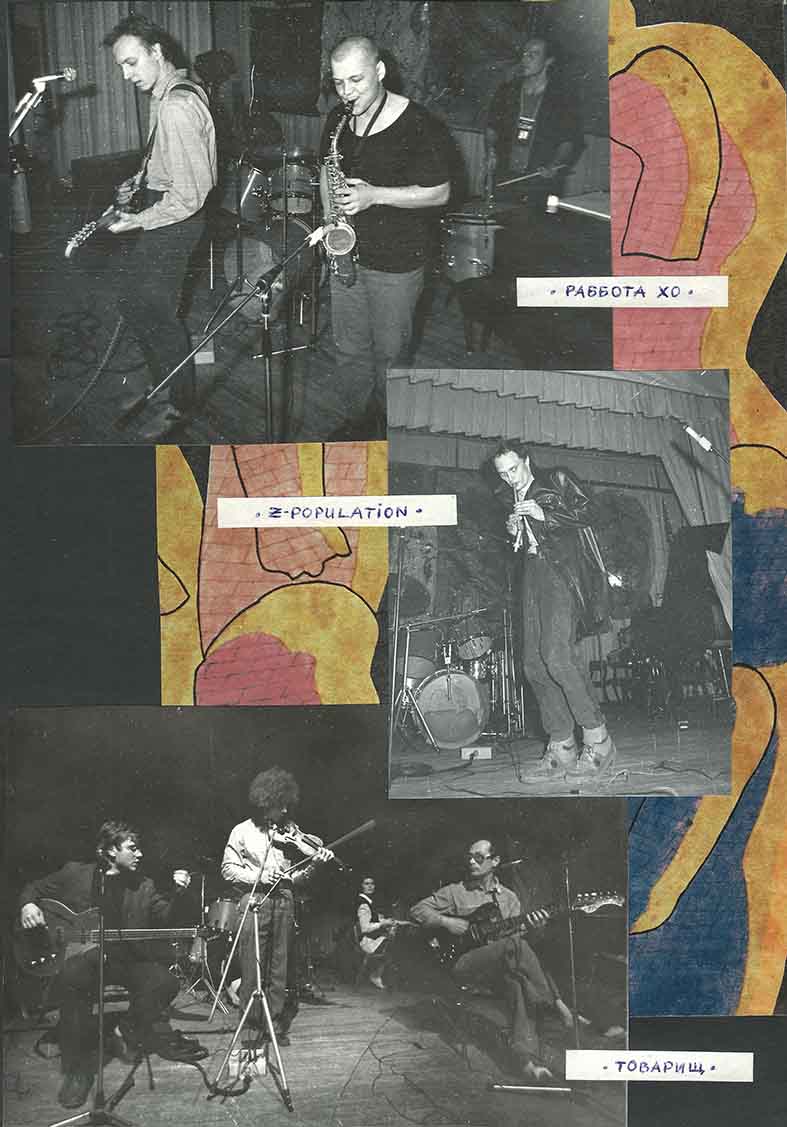
From the 'Положение Дел' [State of Affairs] magazine, 1991. Serhii Myasoyedov’s archive.
Image caption: Integer vulputate libero quis neque pharetra, pretium viverra ex euismod.
At the turn of the decade, the music scene was the most active: the number of events and releases was increasing in line with the relaxation of governmental pressure and the emergence of new opportunities. In 1986, rock clubs were registered in big USSR cities. They existed in opposition and at the same time were open to compromise in terms of control over the music. In 1989-90, musicians got opportunities for touring and making releases abroad. The importance of contacts with independent scenes and labels in Poland, Germany, and other countries can’t be overestimated. Most local underground musicians remain well-known mainly owing to their releases made outside Ukraine. In the 90s, life was full of uncertainties and a music scene was still functioning as a microcosm where like-minded people found support and actualised their creative potential. There were lots of overlaps between music and visual and performative art, between avant-garde within classical music and experiments with Eastern musical traditions or popular genres.
What mainly distinguished independent musicians of the 90s was their music, uncomfortable or totally unsuitable for the emerging local showbiz.
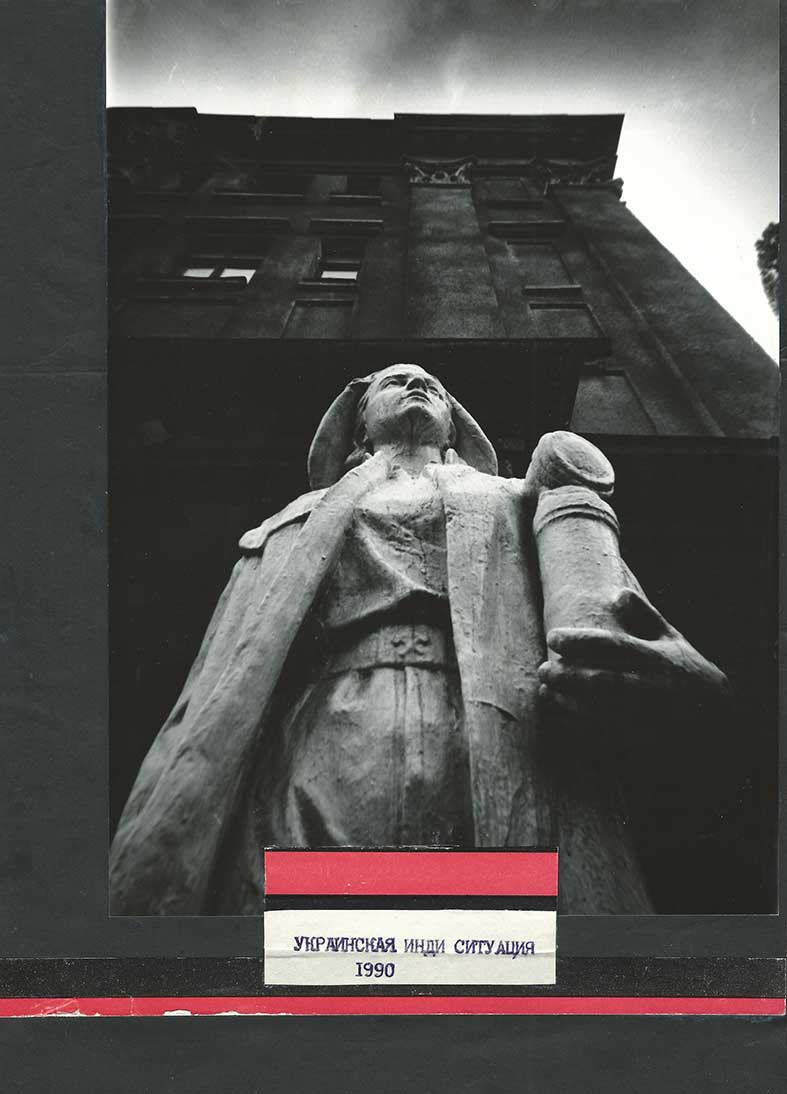
From the 'Положение Дел' [State of Affairs] magazine
Names
We owe what we know about the phenomenon of Ukrainian independent of the 80-90s mainly to the music scenes of the two biggest cities, Kyiv and Kharkiv. There were some popular figures and bands from other regions but we still can’t place them in a coherent picture because of a lack of information. There was a quite narrow circle of like-minded musicians in the USSR and each city had certain groups that brought together musicians open to experiment who later on created their own projects, sometimes radically changing their style.
Created at the beginning of the 80s as the improvisational formation ‘KGB’ (named after the band members’ initials: Kyiivtsev, Goidenko, Butuzov), ‘Коллежский Асессор’ [Kollegskiy Assessor] was among the first Kyiv-based bands and the most legendary one. Over time, their music had evolved from spontaneous improvisations to more vibrant performances and guitar parts had grown in significance. That was when the name ‘Kollegskiy Assessor’ appeared. Later, Butuzov and Kyiivtsev started their own projects and were replaced by musicians of the younger generation.
The community Rock Artel was created as the opposition to the Kyiv rock club during the last years of the USSR and included ‘Kollegskiy Assessor,’ ‘Rabbota Ho,’ and ‘Vopli Vidoplyasova.’ These three bands didn’t have much in common and the community shortly collapsed. At the turn of the decade, there were lots of independent festivals held in Kyiv: ‘Чорна Рада’ [Black Council] (1990), ‘Полный гудбай’ [Total Goodbye] (1990 and 1991), ‘Музыка в стиле КИН’ [Music in the style of КИН] which took place in the ‘КИН’ theatre on Obolon district, ‘Dead End’ (1992), and individual concerts in the Skew Caponier of the Kyiv Fortress.
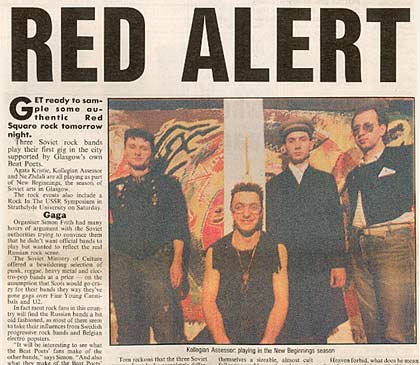
‘Kollegskiy Assessor.’ From the band’s Internet page.
‘Cukor Bila Smert’ [Sugar White Death], ‘Ivanov Down,’ ‘Yarn,’ and ‘Sheik Hi-Fi’ were created one after another during 1989-1991. These were the projects of a very interesting circle of Kyiv-based musicians whose music was influenced, in different combinations, by avant-garde classics, noise or post-industrial, European or Eastern Medieval traditions. ‘Blemish’ and ‘Вербахльос’ appeared shortly after. In the middle and second part of the 90s, these musicians were mainly active as hometapers: they recorded music and made copies on their own. Their music, as well as lineups, was changing from one set to another. Clearly, I haven’t mentioned a lot of bands. The Kyiv underground scene consisted of many very different artists who shared a common space and a personal approach to music creation but weren’t similar music-wise.
The community around Oleksandr Panchenko, leader of the ‘Товарищ’ [Comrade] band, created owing to his interests and willingness to experiment, was kind of a talent pool for the new music in Kharkiv. Most band members who started playing quite early and were students of the Kharkiv Music Boarding School at that time, created their own projects later on: ‘Elza,’ ‘Чужой’ [Alien], and ‘Chichka-Drichka.’
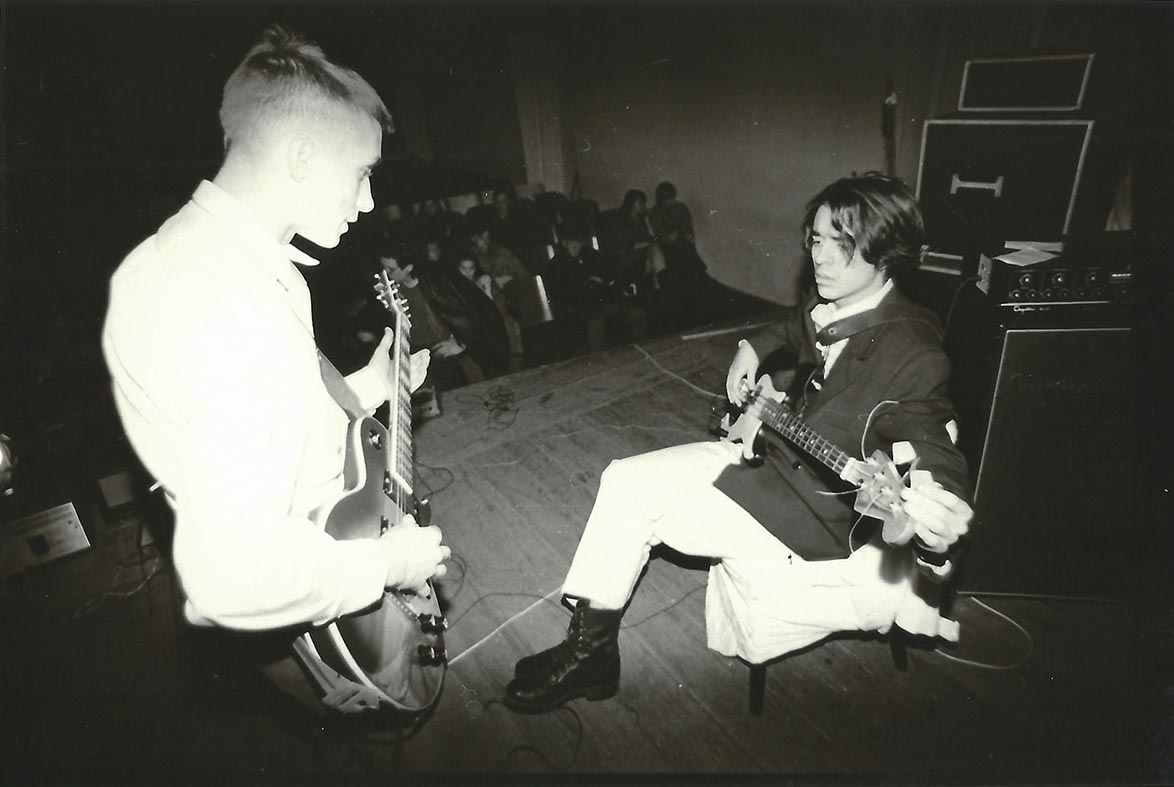
«Ivanov Down in Kharkiv». From the Serhii Myasoyedov’s archive
Most Kharkiv-based offbeat formations were members of the union ‘Novaya Scena’ [New Scene] which organised festivals and performances in Kharkiv and other cities and distributed records. Its director Serhii Myasoyedov worked on engaging avant-garde and original Ukrainian bands in the context of European independent music. Thanks to releasing several cassette compilations and a CD ‘Novaya Scena. Underground From Ukraine! 14 Bands From Kiev & Kharkov’ in Germany, some English-speaking listeners learned the name of ‘Novaya Scena’ and could use it as a generic term for Ukrainian independent of the 90s. Musicians from other cities would unlikely agree on such a definition.
After three big festivals of the same name held in 1988, 1990, and 1992, with the latter also taking place in Kyiv and Donetsk, three ‘Культ Модерну’ [Cult of Modern] festivals we organised during 1994-1996, combining music with visual and performative arts.
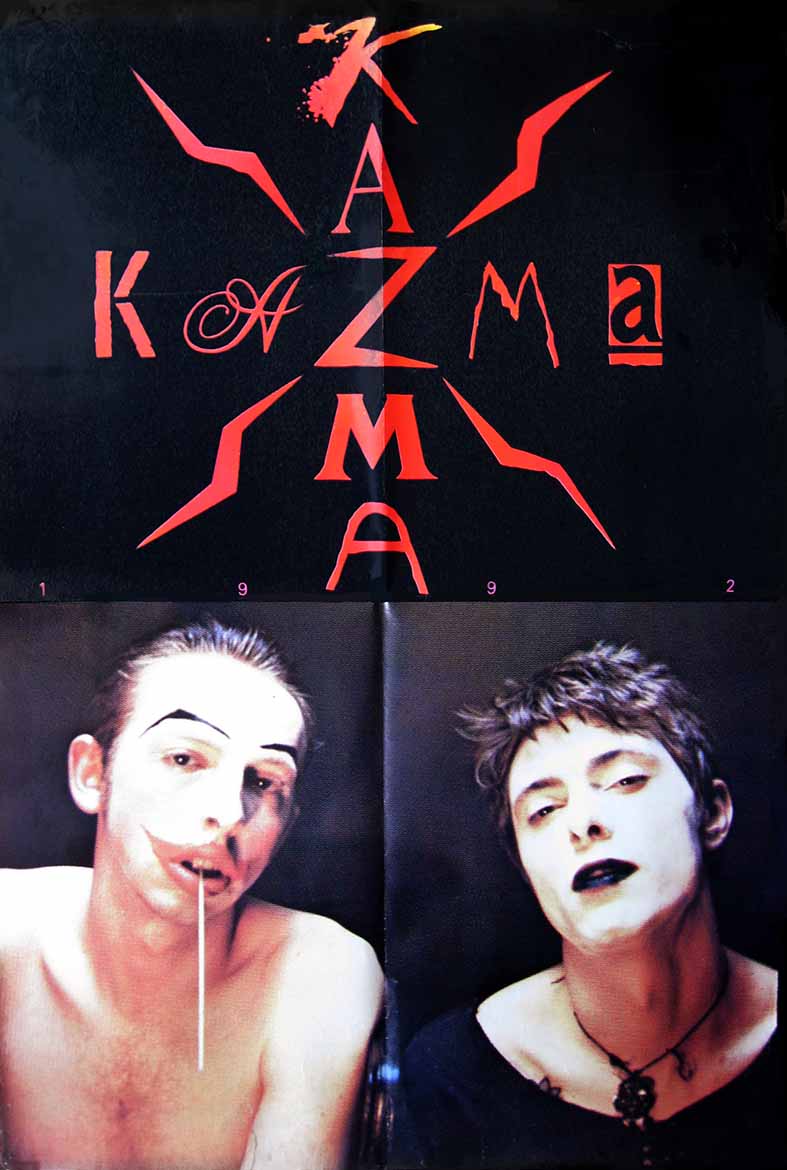
‘Kazma Kazma’ poster of 1992 with the photo by Serhii Bratkov
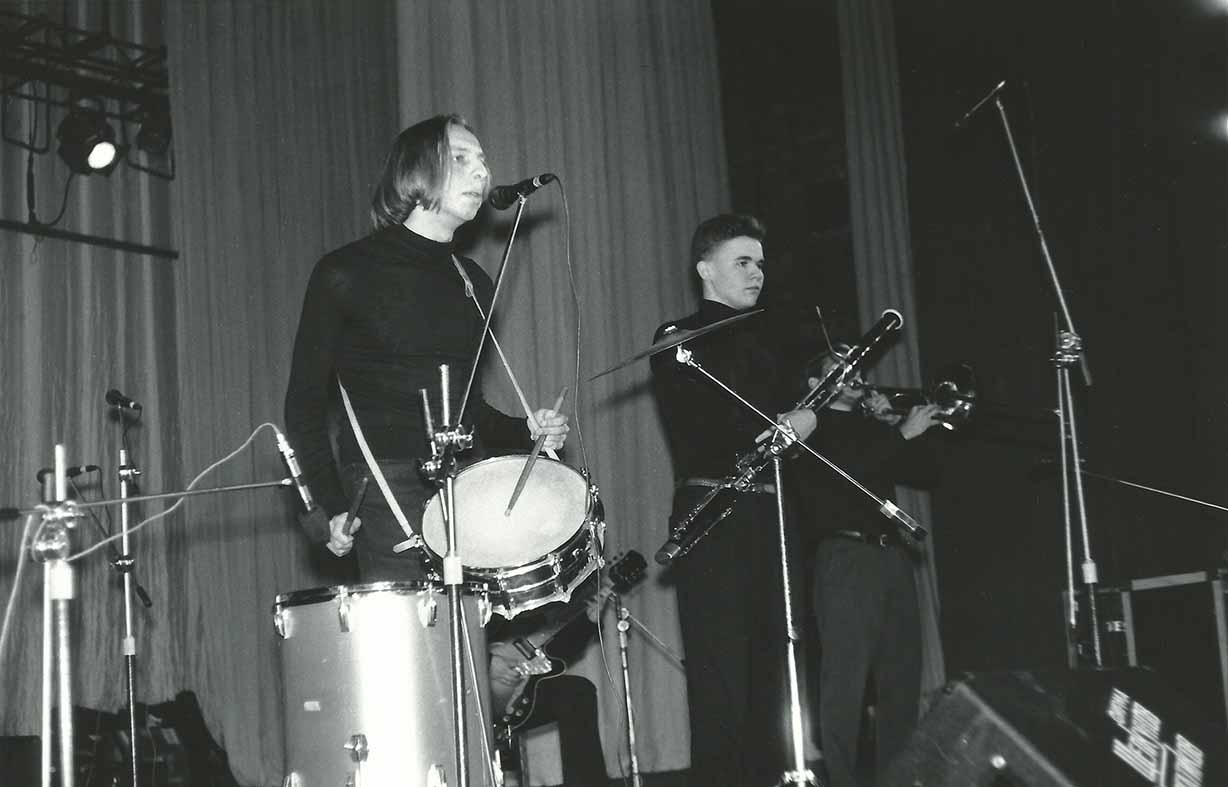
Yevgen Hodosh and Serhii ‘Fahot’ Mykhailyuta, ‘Kazma Kazma,’ 1994. Photo by Vlad Urazovsky. From the Serhii Myasoyedov’s archive.
At the end of 1990, Yevgen Hodosh, ex-member of ‘Товарищ’ and ‘Chichka-Drichka,’ created ‘Kazma Kazma.’ The band had seven musicians and included the extended wind section, combining orchestra arrangements and Medieval melos with dark humour and avant-garde rock vibe. They shortly became the most prominent band of the Kharkiv independent scene. In the middle of 90s, Hodosh launched his own label ‘Paradise Delight of Bianka’ that released a compilation of mostly Kyiv-based bands called ‘Сховайся’ [Hide]. ‘Foa Hoka’ from Chernihiv became the most successful band of ‘Novaya Scena’ at that time. After the last big festival ‘Східний експрес’ [East Express] held in 1997, ‘Novaya Scena’ came to an end.
‘Альтернатива’ [Alternative] was the largest festival of Ukrainian independent music in the 90s. It took place in Lviv in 1994 and 1995. Obviously, not each band of many that performed there was of experimental and uncompromising nature. However, the festival ideologist who shaped its concept, Ruslan Koshiv defined that the festival was aimed at placing the spotlight on independent music and musicians with the urge to create something new and unconventional as a counterbalance to the overwhelming showbiz commerce. Lviv-based bands ‘999,’ ‘Пам’ятки архітектури’ [Architectural Monuments], and ‘Neborak’ performed at ‘Альтернатива.’ Igor Tsymbrovsky’s performances were a separate phenomenon of the offbeat Lviv music, possibly the brightest one. His one-of-a-kind piano or keyboard improvisations with modernist poetry sang in falsetto voice were reshaped into a song form and recorded on a single published album ‘Прийди Янголе’ [Come, Angel].
Odesa had its own music scene, with such bands as ‘Нормандия-Неман’ [Normandie-Niemen], ‘Мертвый Театр’ [Dead Theatre], ‘Кошкин дом’ [Cat House], festivals and TV shows about independent music. At the ‘Гітарний синдром’ [Guitar Syndrom] festival in Mykolaiv, there were, among others, ‘Будни Модеста Павловича’ [Days of Modest Pavlovych] from Mykolaiv and ‘Реліктові Вантажівки’ [Relict Trucks] from Zaporizhzhya. Both bands played in the manner of Western noise rock with thick sound and swift, broken guitar riffs.
Independent bands from Kremenchyk, Donetsk, Ivano-Frankivsk, Ternopil, and other cities could also be mentioned. Many of them performed at the ‘Альтернатива’ festival in Lviv. Improvisational music was a specific part of the 90s underground, quite poorly known. Musicians of that time could fall within the context of modern classical music or avant-garde jazz (like Zmorovych, Nesterov, Yaremchyk) or could be left out. This multifaceted topic has received insufficient attention and still waits for further research.
Some initiatives to archive and revisit Ukrainian 80-90s underground started out at the beginning of the 2000s, when Edward Sol’s label ‘Quasi Pop Records’ released a series of compilations and records. New music projects were released along with archived materials.
Scattered discussions in the blogosphere emerged at the same time, and members of the 90s music circles started publishing their materials and records online. Then, there were some articles in the media but mostly limited to Kyiv-based bands. Publications in the self-published ‘Аутсайдер’ [Outsider] magazine deserve particular attention. Some sections of books written by musical journalist Oleksandr Yevtushenko are also dedicated to above-mentioned bands but in general, his works stay on track with the 90s music press mainstream which shaped the concept of a radio format applicable to Ukrainian pop and rock music.
Tetiana Yezhova has been working on a film about the Kyiv independent rock scene of 1986-1995 since the end of the 2000s. Interviews with many figures of the Kyiv scene were included in the two-part film ‘Дайте звук, будь ласка!’ [Turn On the Sound, Please!] (2016-2017). There are lots of archive photos, records, and other materials in Tetiana’s blog and a Facebook page created for former scene members’ consolidation.
Also, music lovers and ‘music archeologists’ from all over the world have been showing an increasing interest in the Ukrainian underground of the 90s. Their image of the independent scene of that time, not in several cities of Ukraine but the whole country, is based on the brightest records available online. What they generally focus on goes in line with the principles of the Lviv ‘Альтернатива’ festival, Polish ‘Koka Records,’ Kharkiv ‘Novaya Scena’ of the 90s, and releases of the ‘Quasi Pop Records’ label from the beginning of the 2000s: they are mainly interested in unconventional music which has the individual approach and exists out of either genre or local contexts.
Many retrospective articles were published in past five years, as well as some biographical materials, written in English, Polish, and other languages. But we still don't have any profound publications that would review the scene as a whole or analyse musicians’ development and transformations after the 90s.
The lack of information about musicians, especially those who weren't members of the Kyiv scene, causes numerous factual mistakes and myths in the press. Thus, publishing documents, music records, and extensive interviews with prominent figures could improve the situation. To explore the first such compilation which presents the history of the early musical underground in Ukraine through video fragments available online, follow the link (UA, soon will be available in English).
You can also listen to the records here and here
Some other materials:
A brief review of the Kyiv independent movement and some 90s album reviews by Roman Pishchalov
The history of the 90s Ukrainian underground in the ‘Koka Records’ label releases
–
Oleksandr Klochkov is a Kyiv-based researcher and artist. Since 2010, he has been a member of the enthusiast group that explores and gives publicity to the history of Ukrainian independent music. Works with the archives of the ‘Novaya Scena’ union (Kharkiv) since 2016.
–
